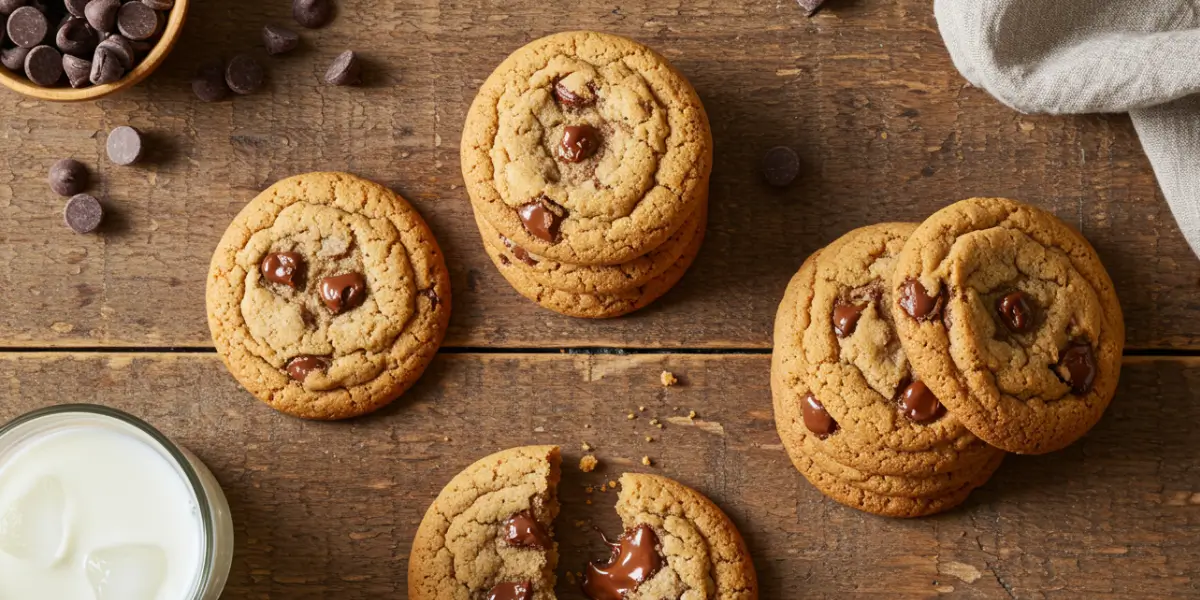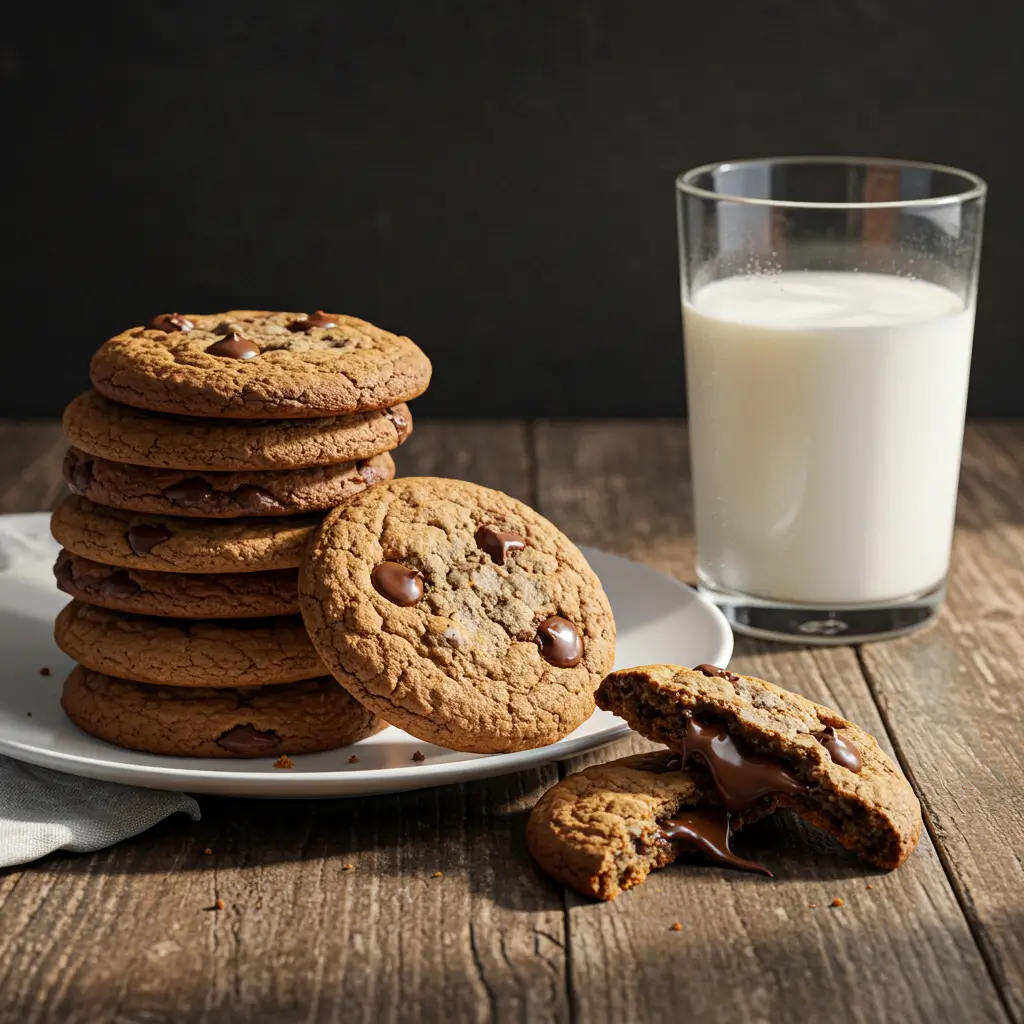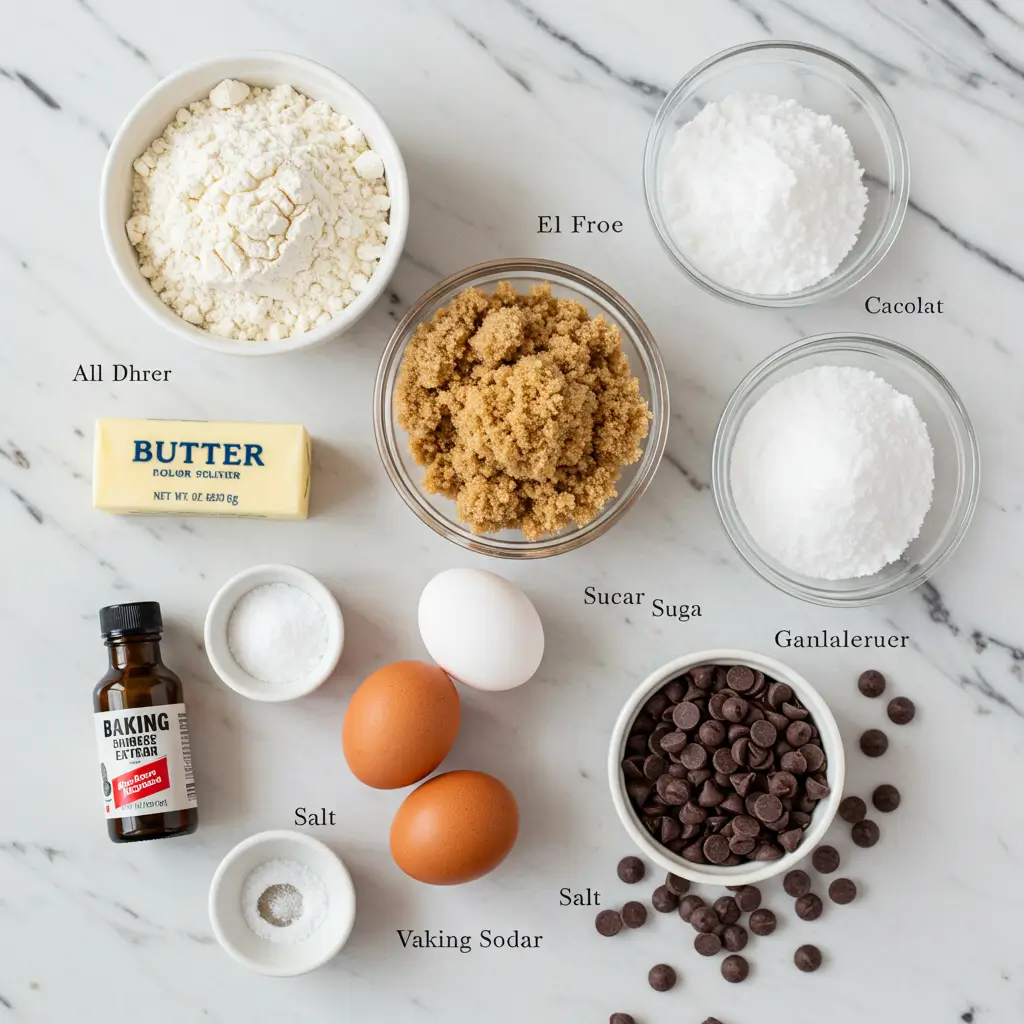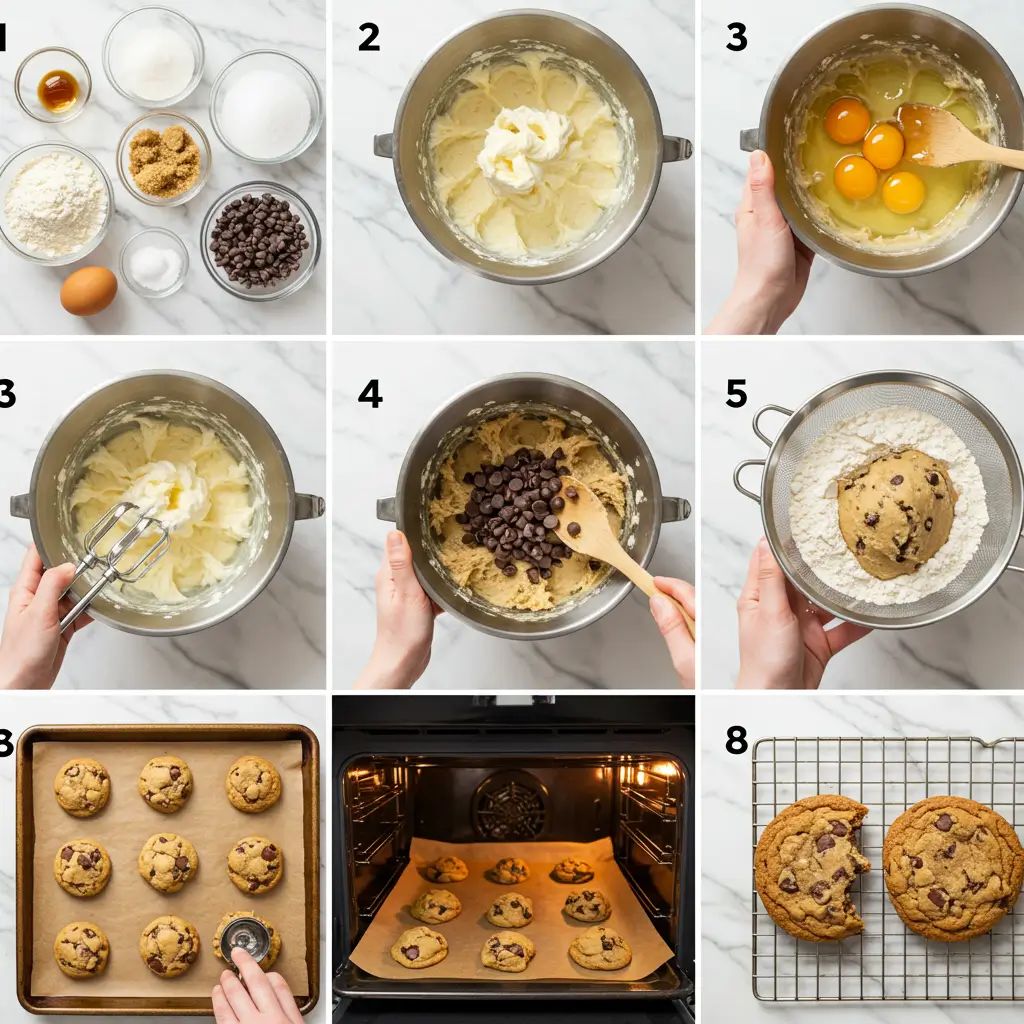The Perfect Chocolate Chip Cookies

There’s something magical about the aroma of freshly baked chocolate chip cookies wafting through your kitchen. That moment when you pull a tray of golden-brown cookies from the oven, their edges crispy and centers still soft, transports you back to childhood memories of baking with loved ones. Whether you’re a seasoned baker or someone who’s never cracked an egg, mastering the art of chocolate chip cookies is a journey worth taking. These beloved treats have been bringing smiles to faces for generations, and today, you’re going to learn exactly how to create bakery-quality cookies in your own home.
The History and Science Behind Chocolate Chip Cookies
???? Chocolate Chip Cookies Recipe
The Ultimate Classic American Cookie
???? Ingredients
- 2 1/4 cups all-purpose flour
- 1 cup unsalted butter, softened (2 sticks)
- 3/4 cup granulated white sugar
- 3/4 cup packed brown sugar
- 2 large eggs
- 2 teaspoons vanilla extract
- 1 teaspoon baking soda
- 1 teaspoon salt
- 2 cups semi-sweet chocolate chips
✓ Pros
- Simple ingredients that are kitchen staples
- Perfect crispy edges with soft, chewy centers
- Quick preparation time under 30 minutes
- Freezer-friendly dough for fresh cookies anytime
- Highly customizable with add-ins and variations
- Crowd-pleasing classic loved by all ages
✗ Cons
- High calorie and sugar content per serving
- Requires precise oven temperature control
- Best enjoyed fresh within 2-3 days
- Can spread too much if dough isn’t chilled
- Butter must be at exact room temperature
???????? Instructions
- Preheat your oven to 350°F (175°C) and line two baking sheets with parchment paper.
- In a medium bowl, whisk together flour, baking soda, and salt. Set aside.
- In a large mixing bowl, cream together softened butter, granulated sugar, and brown sugar using an electric mixer on medium speed for 3-5 minutes until light and fluffy.
- Beat in eggs one at a time, ensuring each is fully incorporated. Add vanilla extract and mix until combined.
- Gradually add the dry ingredient mixture to the wet ingredients, mixing on low speed just until combined. Do not overmix.
- Gently fold in chocolate chips using a spatula until evenly distributed throughout the dough.
- Cover the dough and refrigerate for at least 30 minutes to prevent excessive spreading during baking.
- Using a cookie scoop or tablespoon, portion dough into balls and place them 2-3 inches apart on prepared baking sheets.
- Bake for 10-12 minutes until edges are golden brown but centers still look slightly underdone.
- Remove from oven and let cookies cool on the baking sheet for 5 minutes before transferring to a wire rack.
- Allow cookies to cool completely on the wire rack before serving or storing in an airtight container.
The Accidental Invention That Changed Baking Forever
Did you know that chocolate chip cookies were created by accident? In 1938, Ruth Wakefield, owner of the Toll House Inn in Massachusetts, added chopped chocolate to her cookie dough expecting it to melt completely. Instead, the chocolate pieces held their shape, creating the first batch of chocolate chip cookies. This happy accident became America’s favorite cookie, and understanding this history helps you appreciate why your chocolate chip cookies deserve the same attention to detail.

The Chemistry of Perfect Cookie Texture
The texture of your chocolate chip cookies depends on a delicate balance of ingredients and techniques. Butter provides richness and spread, while sugar creates crispness and caramelization. Brown sugar, with its molasses content, adds moisture and chewiness to your chocolate chip cookies. Eggs bind everything together and contribute to structure, while baking soda helps cookies spread and develop those coveted crispy edges. When you understand these chemical reactions, you’ll know exactly how to adjust your recipe for your perfect cookie.
Why Temperature Matters in Cookie Making
Temperature control is the secret weapon in baking exceptional chocolate chip cookies. Room temperature ingredients blend more smoothly, creating a uniform dough. Cold dough prevents excessive spreading and results in thicker cookies. Your oven temperature determines whether you get crispy, chewy, or cakey cookies. Even the temperature of your baking sheets affects the final result—preheated sheets create crispier bottoms, while cool sheets yield softer cookies.
Essential Ingredients for the Best Chocolate Chip Cookies
Choosing the Right Flour and Leavening Agents
All-purpose flour is your go-to choice for classic chocolate chip cookies, but the type of flour significantly impacts texture. Bread flour creates chewier cookies due to higher protein content, while cake flour yields softer, more tender results. Baking soda is essential for spread and browning, but some recipes include baking powder for extra lift. The key is using fresh leavening agents—expired baking soda won’t give your chocolate chip cookies the rise they need.

Ingredients
- All-purpose flour – 2 1/4 cups (4 1/2 cups for double)
- Butter (unsalted) – 1 cup / 2 sticks (2 cups / 4 sticks for double)
- Granulated sugar – 3/4 cup (1 1/2 cups for double)
- Brown sugar – 3/4 cup (1 1/2 cups for double)
- Eggs – 2 large (4 large for double)
- Chocolate chips – 2 cups (4 cups for double)
- Baking soda – 1 tsp (2 tsp for double)
- Salt – 1 tsp (2 tsp for double)
- Vanilla extract – 2 tsp (4 tsp for double)
The Butter vs. Margarine Debate
Real butter is non-negotiable for authentic chocolate chip cookies. Butter contains about 80% fat and 20% water, creating steam during baking that contributes to texture and flavor. Margarine simply cannot replicate the rich, complex flavor that butter provides. For the best results, use unsalted butter so you can control the salt level in your chocolate chip cookies. European-style butter, with its higher fat content, creates even more luxurious cookies.
Sugar Varieties and Their Impact
The sugar ratio in your chocolate chip cookies determines their texture and sweetness level. Granulated white sugar promotes spreading and crispness, while brown sugar adds moisture, chewiness, and caramel notes. Most recipes use a combination of both sugars to achieve balanced flavor and texture. Dark brown sugar contains more molasses than light brown sugar, creating richer, more complex flavors in your chocolate chip cookies.
Step-by-Step Guide to Baking Chocolate Chip Cookies
Preparing Your Dough for Success
Start by creaming room-temperature butter with both sugars until light and fluffy—this typically takes 3-5 minutes with an electric mixer. This process incorporates air into your dough, creating lighter chocolate chip cookies. Add eggs one at a time, beating well after each addition, then mix in vanilla extract. In a separate bowl, whisk together flour, baking soda, and salt before gradually adding to the wet ingredients. Overmixing at this stage develops too much gluten, resulting in tough cookies.
The Art of Adding Chocolate Chips
The type of chocolate you choose dramatically affects your chocolate chip cookies. Semi-sweet chocolate chips are classic, but dark chocolate creates a more sophisticated flavor profile, while milk chocolate appeals to those with a sweeter tooth. For best results, use a combination of chocolate chips and chopped chocolate bars—the irregular pieces create pockets of melted chocolate throughout your cookies. Fold chocolate into the dough gently to distribute evenly without overworking the mixture.
Baking Techniques for Perfect Results
Chill your cookie dough for at least 30 minutes before baking—this prevents excessive spreading and allows flavors to develop. Scoop uniform portions using a cookie scoop to ensure even baking. Space cookies 2-3 inches apart on parchment-lined baking sheets. Bake at 350°F (175°C) for 10-12 minutes, removing when edges are golden but centers still look slightly underdone. Your chocolate chip cookies will continue baking on the hot sheet, resulting in perfectly chewy centers.

Advanced Tips and Variations for Chocolate Chip Cookies
Achieving Different Textures
Want crispy chocolate chip cookies? Bake them longer at a slightly lower temperature, and use more white sugar than brown sugar. For chewy cookies, increase brown sugar, slightly underbake, and remove from the oven when centers are still soft. If you prefer cakey cookies, add an extra egg and reduce the butter slightly. You can also experiment with adding cornstarch to create ultra-soft, bakery-style chocolate chip cookies.
Creative Flavor Combinations
While classic chocolate chip cookies are perfection, variations keep things exciting. Add chopped nuts like walnuts or pecans for crunch and depth. Mix in toffee bits, caramel chips, or white chocolate for new flavor dimensions. A pinch of espresso powder enhances chocolate flavor without making cookies taste like coffee. Sea salt sprinkled on top before baking creates an addictive sweet-salty combination that elevates your chocolate chip cookies to gourmet status.
Storage and Freezing Strategies
Store baked chocolate chip cookies in an airtight container at room temperature for up to one week. Place a slice of bread in the container to maintain softness—the bread dries out while keeping cookies moist. For longer storage, freeze baked cookies in freezer bags for up to three months. You can also freeze cookie dough balls and bake them straight from frozen, adding 1-2 minutes to the baking time—perfect for fresh chocolate chip cookies whenever cravings strike.
Troubleshooting Common Cookie Problems
Why Your Cookies Spread Too Much
If your chocolate chip cookies spread into thin pancakes, several factors could be responsible. Using melted butter instead of softened butter causes excessive spreading. Insufficient flour or too much sugar also creates flat cookies. Your oven temperature might be too low, allowing cookies to spread before setting. The solution? Chill your dough, measure ingredients accurately, check your oven temperature with a thermometer, and ensure your butter is softened but not melted.
Solving Dry or Crumbly Cookie Issues
Dry, crumbly chocolate chip cookies result from too much flour, overbaking, or insufficient fat. Always measure flour correctly by spooning it into measuring cups and leveling off—don’t pack it down. Remove cookies from the oven when they look slightly underdone in the centers. If your dough seems too dry before baking, add a tablespoon of milk or cream to restore moisture. Remember that cookies firm up as they cool, so what looks underdone often becomes perfect.
Fixing Cakey Texture Problems
If your chocolate chip cookies turn out more like cake than cookies, you’re likely using too much flour, too many eggs, or overmixing your dough. Reduce flour by a few tablespoons, or use one less egg white. Avoid overbeating the dough after adding flour, as this develops excess gluten. Also, ensure your baking powder is fresh—old leavening agents can affect texture unpredictably.
Chocolate Chip Cookie Recipe Comparison Table
| Cookie Style | Butter Temp | Sugar Ratio (White:Brown) | Baking Time | Texture Result |
|---|---|---|---|---|
| Classic Chewy | Room temp | 1:1 | 10–12 min | Soft center, crisp edges |
| Crispy Thin | Melted | 2:1 | 12–14 min | Crispy throughout |
| Thick & Soft | Cold | 1:2 | 11–13 min | Cake-like, puffy |
| Bakery Style | Room temp | 1:1.5 | 12–15 min | Thick, chewy center |
FAQs About chocolate chip cookies
Q: Why do my chocolate chip cookies turn out flat instead of thick and chewy?
A: Flat chocolate chip cookies typically result from using melted butter, insufficient flour, too much sugar, or warm dough. To fix this, make sure your butter is softened but not melted, measure flour accurately using the spoon-and-level method, and always chill your cookie dough for at least 30 minutes before baking. Also, check your oven temperature with a thermometer—if it’s too low, cookies spread before they set.
Q: How can I make my chocolate chip cookies taste like bakery-quality cookies?
A: Bakery-style chocolate chip cookies achieve their superior taste through several techniques. Use a combination of bread flour and all-purpose flour for chewier texture, brown your butter for nutty complexity, and use chopped chocolate bars instead of just chips. Chill your dough for 24-72 hours to develop deeper flavors, and sprinkle sea salt on top before baking. These professional techniques transform ordinary chocolate chip cookies into extraordinary treats.
Q: Can I substitute ingredients in chocolate chip cookies without ruining them?
A: While chocolate chip cookies are somewhat forgiving, some substitutions work better than others. You can replace vanilla extract with almond extract (use half the amount), swap chocolate chips for chunks or other mix-ins, or use coconut oil for butter in a 3:4 ratio. However, avoid replacing all-purpose flour with whole wheat flour without adjusting liquid, and don’t substitute baking soda with baking powder directly—they function differently in chocolate chip cookies.
Q: What’s the secret to keeping chocolate chip cookies soft for days?
A: The key to keeping chocolate chip cookies soft is proper storage and slight underbaking. Remove cookies from the oven when centers still look slightly underdone—they’ll continue baking on the hot pan. Once completely cooled, store in an airtight container with a slice of bread, which releases moisture that cookies absorb. For maximum softness, add an extra egg yolk or tablespoon of cornstarch to your dough.
Conclusion: Your Journey to Perfect Chocolate Chip Cookies
Mastering chocolate chip cookies is more than following a recipe—it’s understanding the science, technique, and passion behind every batch. You now have the knowledge to troubleshoot problems, customize textures, and create cookies that rival any bakery. Remember that the best chocolate chip cookies come from practice, experimentation, and lots of taste-testing along the way.
The beauty of chocolate chip cookies lies in their versatility and the joy they bring to everyone who tastes them. Whether you prefer yours crispy, chewy, loaded with chocolate, or studded with nuts, there’s no wrong way to enjoy these timeless treats. Each batch you bake is an opportunity to create memories and share happiness with others.
Ready to bake your best batch yet? Grab your ingredients, preheat that oven, and start creating chocolate chip cookies that will have everyone asking for your secret recipe. Don’t forget to share your results and any creative variations you discover—the cookie-baking community thrives on shared passion and delicious experimentation!
???? Reviews & Ratings
See what our community is saying about this Chocolate Chip Cookies recipe

